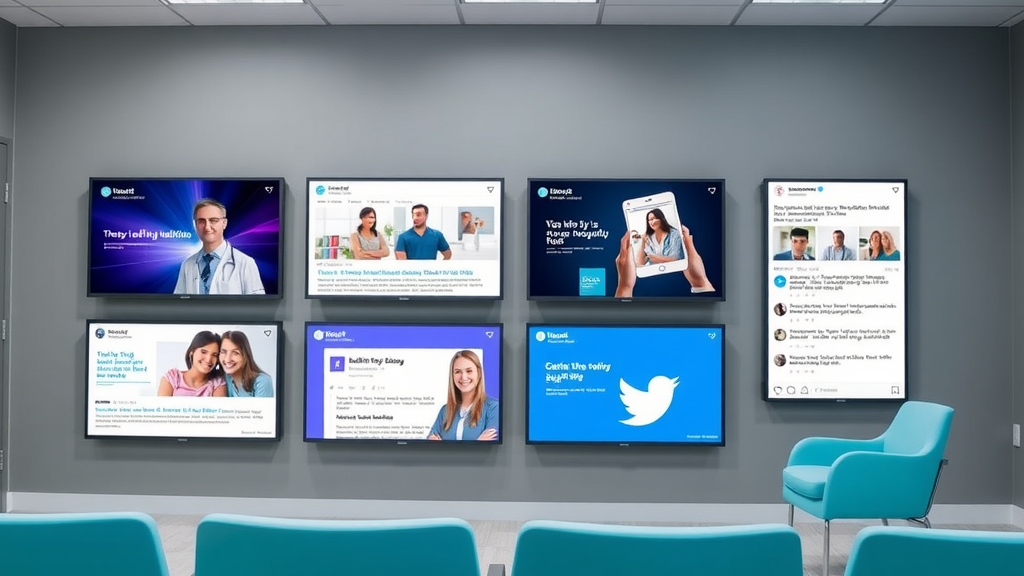Did you know that over 72% of patients research online before choosing a healthcare provider? In today’s digital-first world, content marketing for medical practices is vital—not just to acquire new patients, but to build trust, establish your expertise, and ensure steady growth. This guide dives deep into proven tactics that will help your practice shine online, engage both prospective and existing patients and develop an authentic reputation in the healthcare industry.
Unlocking the Power of Content Marketing for Medical Practices
Modern patients rely on online resources for making informed decisions. With the majority using search engines and social media to research symptoms, treatments, and providers, there’s never been a more critical time to invest in healthcare content marketing. High-quality, trustworthy content positions your medical practice as a go-to resource, increasing the likelihood that patients will trust your expertise.
Practices that leverage content marketing see significantly higher brand awareness and patient engagement than those that rely solely on traditional advertising. From blog posts to engaging video content, the right marketing strategies can distinguish your practice in an increasingly competitive healthcare market.
An effective content marketing strategy bridges the gap between your expertise and what patients are actively searching for. By investing in robust healthcare content creation—such as blog posts, testimonials, and social media updates—you’re not only meeting patient needs but also improving your visibility in search engines, ultimately attracting more potential patients to your practice.
What You'll Gain from Mastering Content Marketing for Medical Practices
Mastering content marketing for medical practices isn’t just about posting information. It’s about educating patients, nurturing long-term relationships, and solidifying your medical practice as a thought leader. You’ll learn how to craft engaging blog posts, optimize your presence on social media platforms, and measure the real impact of your content strategy. The guide goes further with wisdom from thought leaders in the healthcare industry who’ve set benchmarks for patient-centric care marketing.
Each section is designed to provide both a big-picture strategy and practical tips you can use immediately. As you apply these principles, you’ll notice improved patient satisfaction, stronger online reviews, and a growing community of patients who see your medical practice as a trusted healthcare provider. Get ready to transform your digital marketing efforts into measurable results.

Content Marketing for Medical Practices: Core Principles and Strategy Overview
Content marketing for medical practices revolves around creating and distributing valuable, targeted, and consistent healthcare content to attract, educate, and retain patients. Unlike traditional advertising, which focuses on direct promotion, content marketing builds a foundation of trust and authority by providing real information that patients genuinely seek. This may include detailed blog posts on medical conditions, videos explaining treatment options, or infographics breaking down complex procedures into understandable terms.
Becoming a thought leader in healthcare content marketing isn’t reserved for hospitals or large providers. Even a small medical practice can establish itself as a trusted source by addressing common patient concerns, providing up-to-date health information, and engaging users across digital channels. Consistency and a patient-centric approach are critical to standing out in the crowded healthcare market. By focusing on quality content that puts patient needs first, your medical practice can attract potential patients while strengthening bonds with existing ones.
Ultimately, the goal is not just to attract new patients but to build trust and loyalty over time. When you shift your focus from promotional messaging to solving real patient problems through valuable content, you pave the way for long-term practice growth and a positive reputation in the healthcare industry.

The Essential Role of Healthcare Content Marketing in Patient Engagement
Patient engagement is at the heart of any successful content marketing strategy. Today’s patients are informed and digitally savvy and expect healthcare providers to address their concerns proactively, well before a face-to-face consultation. Healthcare content marketing fulfills this by providing accurate health information to answer questions, reduce anxiety, and empower patients to participate actively in their care.
Strategically developed blog posts, Q&A videos, and real-world patient testimonials put relevant info directly into the hands of your audience. This engagement improves patient satisfaction and outcomes while fostering a sense of loyalty. Over time, as patients see your practice consistently offering high-quality content, your reputation as a thought leader grows.
Engaging content also serves as a bridge between your medical expertise and the needs of potential patients. By anticipating common questions and concerns, your practice proactively builds meaningful relationships, increases patient retention, and encourages referrals—all essential for long-term success.

Why a Content Marketing Strategy Matters for Every Medical Practice
"Content marketing for medical practices builds lasting relationships by providing value beyond the clinic—educate, inspire, build trust."
A solid content marketing strategy gives your medical practice a competitive advantage, especially in a digital landscape where information is abundant. Without a structured approach, it’s easy to get lost in the sea of generic health advice and forgettable campaigns. A well-planned strategy outlines your goals, defines your target audience, and ensures each piece of content aligns with both patient needs and your overall business objectives.
For medical practices, this means identifying the most critical touchpoints in the patient journey—whether it’s the first time they search for a health solution or when they need guidance on managing chronic conditions after a visit. With the right marketing strategies, your practice can transform from a service provider to a trusted resource patients return to and recommend to others.
In short, a thoughtful content marketing strategy not only improves search engine performance and brand perception but also positions your team as true thought leaders within the healthcare industry.

Building Your Content Marketing Strategy: Setting the Foundation for Medical Practices
Every successful content marketing strategy starts with well-defined goals. Do you want to increase brand awareness, become known as a thought leader, generate leads, or deepen loyalty with existing patients? These objectives will influence the types of healthcare content you create and the distribution channels you use—be it educational blog posts, engaging video content, or live Q&A sessions on social media.
Aligning your marketing strategy with business objectives ensures your team stays focused and your efforts are measurable. For instance, if your practice aims to educate patients about preventive care, creating a blog post series and downloadable guides on wellness topics could help build trust while supporting improved patient outcomes.
To position your practice as a trusted healthcare provider and thought leader, highlight your areas of expertise, share insights into emerging health trends, and offer transparent communication. Over time, this not only enhances your reputation but also strengthens patient loyalty and community referral rates.

Identifying and Understanding Your Target Audience and Potential Patients
Key Steps to Define Target Audience:
-
Demographics
-
Health concerns
-
Preferred communication channels
-
Decision-making factors
Knowing your target audience is fundamental for any effective content strategy. Start with demographic details like age, gender, and language preferences—but delve deeper into their health concerns, cultural backgrounds, and the specific pain points your medical practice can solve. For example, a pediatric clinic will need vastly different content than an oncology specialist.
Consider how your potential patients consume information. Do they prefer digestible social media tips or in-depth educational guides? Are they drawn to authentic patient testimonials or explainer videos? You can use surveys, feedback forms, or analytics from your website and social media to refine your messaging and ensure it reaches—and resonates with—the right patients.
By aligning your content marketing with your audience’s real needs, you ensure that each touchpoint is meaningful, driving higher engagement and positioning your medical practice as a genuinely patient-centric healthcare provider.

Researching the Healthcare Market and Competitors
In-depth research of the healthcare market is important for distinguishing your practice from competitors. Analyze local and national healthcare providers to see what kind of healthcare content they’re sharing, which formats perform well, and where there may be gaps your practice can fill.
Consider competitor blog posts, FAQ pages, and social media campaigns—what questions are they answering for patients? What health information do they leave unaddressed? Tools like Google Trends, industry forums, and analytics platforms can help identify emerging topics that matter to your target audience.
Meeting your patients where they are and addressing both their unmet needs and interests positions your practice as a solution-oriented, innovative healthcare provider—enhancing both patient satisfaction and your own digital marketing results.

Choosing the Right Marketing Strategies for Modern Healthcare
There’s no one-size-fits-all approach to healthcare marketing. Modern marketing strategies require a blend of digital campaigns, community outreach, and in-practice patient education. For optimal results, balance tried-and-true tactics, like blog posts and newsletters, with new approaches such as interactive social media campaigns and visually engaging video content.
Leveraging the right channels not only increases visibility in the healthcare market but also drives sustainable patient growth. Whether it’s using Instagram Stories for quick wellness tips or LinkedIn articles to reach professional peers, choose platforms where your target audience is most active and engaged.
Regularly measuring effectiveness ensures you continue to reach your objectives. Test new ideas, experiment with emerging formats, and always remain open to feedback from patients and your marketing team.

Planning Relevant Blog Posts and Video Content for Patient Education
A well-rounded content marketing strategy combines both written and visual content to maximize impact. Educational blog posts should tackle frequently asked health questions, highlight new treatments, and clarify complex medical topics in simple, relatable terms. Video content, on the other hand, brings human connection—use it for patient testimonials, behind-the-scenes practice tours, and explainer videos for common procedures.
Content calendars help map out upcoming blog posts and video themes to ensure consistency and strategic variety. Collaborate with your clinical team to brainstorm topical ideas that address seasonal health challenges or trending patient questions. This keeps your content timely, relevant, and deeply connected to what your patients care about most.
Combining value-packed written information with relatable video content not only educates your patients—it also helps build trust and turns your audience into loyal advocates for your medical practice.

Crafting Quality Healthcare Content that Builds Trust
To develop a reliable content strategy, focus on patient education at every stage. Start by mapping out questions that patients commonly ask before, during, and after appointments. Then, build a library of relevant blog posts, how-to guides, and resource lists that are easy to find on your website and share on social media.
Ensure that your healthcare content is accurate, up-to-date, and accessible. Use plain language and a supportive tone to make sure patients feel empowered and informed. Supplement written materials with visual elements—such as graphics, videos, or infographics—to cater to different learning preferences and boost retention.
Providing high-quality content not only answers questions but also demonstrates your commitment to excellence. By being proactive, you help educate patients beyond clinic walls, which sets you apart as a genuinely caring and knowledgeable healthcare provider.

How Medical Practices Can Drive Trust Through Thought Leadership
"Healthcare providers who publish quality content are viewed as industry thought leaders, increasing consumer trust and loyalty."
Earning a reputation as a thought leader takes time and consistency. Contribute regularly to industry conversations by sharing your unique perspective on healthcare trends, publishing updates about technological advancements, or addressing emerging public health topics. Guest blogging for professional organizations and giving interviews can further amplify your practice’s thought leadership.
Incorporate your team’s credentials and experience in your content. Authored articles from your medical director or Q&A videos led by experienced nurses reinforce your expertise, heighten patient trust, and differentiate your practice from competitors who have yet to establish thought leadership.
By producing content that aligns with patient interests and concerns, your practice is seen as both a resource and a reliable authority—driving ongoing engagement and fostering unwavering loyalty.

Incorporating Patient Stories and Visuals to Make an Impact
Authentic patient stories are some of the most compelling tools in healthcare content marketing. They showcase real-life outcomes and demonstrate your team’s compassion and skill. Always obtain consent before sharing stories, then present them in video, written, or visual formats to highlight the transformative effects of your care.
Complement these narratives with visuals—photos of your team, infographics summarizing treatment plans, or behind-the-scenes glimpses of your practice. Visuals create instant connections, break down complex topics, and help prospective patients envision their experience with your medical practice.
This balanced approach resonates on an emotional level, making your content memorable. Incorporating diverse voices and experiences also strengthens your reputation for inclusivity and genuine patient-centered care.

Leveraging Social Media in Content Marketing for Medical Practices
Social media amplifies your medical practice’s reach, letting you connect authentically with existing and potential patients. The most effective marketing strategies involve consistent posting, responsive engagement, and mixing educational content with community stories or interactive health challenges.
Use specific platforms to achieve unique goals: Facebook for community announcements, Instagram for behind-the-scenes visuals, LinkedIn for professional insights, and YouTube for detailed educational videos. Each channel has its own best practices—such as using hashtags on Instagram or going live for Q&As on Facebook—so tailor your content accordingly.
Respond quickly to messages and feedback on your social accounts to build real-time trust and show that your practice values patient voices. Over time, a proactive, personal approach can drive both brand awareness and patient loyalty.
|
Top Social Channels for Medical Practices |
Content Formats |
Key Benefits |
|---|---|---|
|
|
Live Q&A, Announcements |
Wide Patient Reach |
|
|
Visual Tips, Stories |
Engaging Visuals |
|
|
Articles, Thought leadership |
Professional Credibility |
|
YouTube |
Video content, Tutorials |
Patient Education |

Using Search Engine Optimization (SEO) in Healthcare Content
SEO (Search Engine Optimization) is essential for increasing the visibility of your healthcare content and attracting potential patients organically. Proper keyword placement in blog posts, meta descriptions, headers, and image alt text ensures your content ranks high when patients search for health information related to your practice’s services.
Stay current with search engine algorithms, which reward quality content, mobile responsiveness, and fast page loading. Invest time in building backlinks from reputable medical platforms and encourage patients to leave positive reviews on search portals and healthcare directories.
By focusing on both technical SEO and high-value, patient-focused content, your medical practice will enjoy greater reach, improved website credibility, and consistent growth in patient acquisitions—all achievable through a smart, ongoing SEO effort.

Key Metrics: Measuring Success of Content Marketing for Medical Practices
Measuring your content marketing success is critical for ongoing improvement. Use analytics tools like Google Analytics and social media insights to track core metrics: website traffic, time spent on key blog posts, conversion rates (requests for appointments), and engagement such as social shares and comments.
Consistent tracking allows you to see which content resonates most with your target audience. For example, if wellness videos receive more shares and positive feedback than long-form articles, it’s worth allocating more resources to future video content. Over time, this data-driven approach sharpens your overall marketing strategy and ensures maximum ROI on every effort.
Remember, success is defined by your goals. Track progress toward enhanced patient engagement, increased referrals, and improved brand reputation to see which strategies move the needle for your medical practice.
|
Core Metrics |
Importance |
|---|---|
|
Website Traffic |
Indicates reach |
|
Time on Page |
Reflects content quality |
|
Conversion Rate |
Measures patient acquisition |
|
Social Shares |
Gauges engagement |
High engagement (measured in blog comments, social shares, and direct messages) indicates that your healthcare content is hitting the mark. Pay attention to conversion metrics, like online appointment requests or newsletter sign-ups, to track how well your content is attracting and converting potential patients.
Use deeper analytics—such as user flow through your site or popular entry points—to refine funnels and remove obstacles to conversion. For practices aiming to build trust and brand loyalty, monitor changes in review quality, referral patterns, and repeat visits to your digital channels. Each metric provides insight into what your patients value most.
Adopting a data-driven mindset is key for continual improvement, ensuring your medical practice’s content marketing adapts to evolving patient needs and digital trends.

Creative Content Strategies by Leading Healthcare Providers
Top-Performing Content Marketing Campaigns for Medical Practices:
1. Chronic illness management guides
2. Prevention awareness blog posts
3. Patient-centered video testimonials
4. Thought leader interviews
Innovative medical practices go beyond standard updates and leverage creative storytelling, data-driven infographics, and interactive Q&As. Chronic illness guides, for example, help educate patients dealing with long-term conditions, building loyalty and improving outcomes.
Prevention-focused blog posts and videos drive home the importance of routine exams or lifestyle modifications. Integrating thought leader interviews demonstrates your depth of knowledge and strengthens your network within the healthcare industry—curating a reputation as a go-to source for both patients and peers.
The most successful campaigns incorporate feedback, adjust to audience preferences, and keep patient experience at the forefront of every marketing decision.

Frequently Asked Questions
What is content marketing in the healthcare industry?
Content marketing in the healthcare industry involves producing and sharing valuable, relevant, and consistent content—such as blog posts, videos, and guides—to attract, educate, and engage patients, build trust, and establish thought leadership.
How do I market my medical practice?
To market your medical practice, use a strategic blend of quality healthcare content, targeted social media, patient testimonials, effective SEO, and a patient-centered approach to build relationships and boost brand awareness.
How often should a medical practice publish blog posts?
Consistency is key—publishing at least two to four blog posts per month can keep your audience engaged and demonstrate your practice’s expertise.
What types of video content are most effective in healthcare marketing?
Patient testimonials, educational explainers, provider Q&As, and practice walkthroughs help humanize your brand and build patient trust.
How can a small medical practice compete with larger providers using content marketing strategies?
Focus on niche expertise, personalize your approach, highlight unique patient care stories, and maintain high-quality, consistent content output to stand out.
Are there regulations for healthcare content marketing?
Yes, follow all HIPAA and privacy regulations—protect patient identities, obtain consent for testimonials, and ensure all health information is accurate and compliant.

Take the First Step Toward Smarter Content Marketing
If you’re ready to position your medical practice as a trusted authority in your community, now is the time to invest in a content marketing strategy that works. From blog posts and videos to patient education materials and social media engagement, the right content builds credibility, boosts search visibility, and keeps your patients informed and connected.
Don’t wait to create meaningful relationships that lead to long-term success. Start your content marketing journey today by booking a consultation with our team of healthcare marketing experts , and let us help you turn valuable insights into real patient growth.
 Add Row
Add Row  Add
Add 




Write A Comment